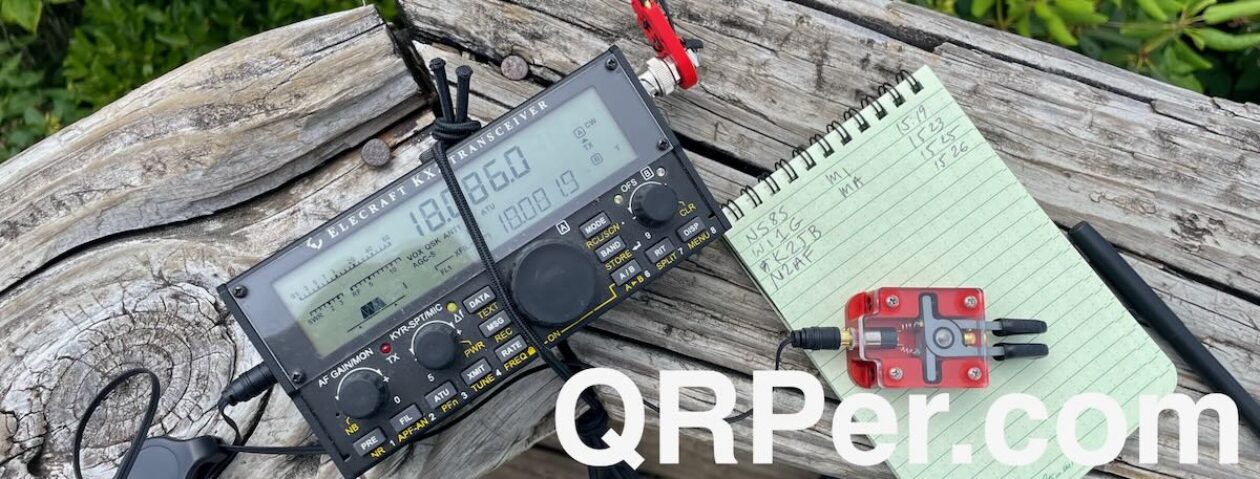Many thanks to Eric (NL5E) who shares the following article about his portable field radio kit which will be featured on our Field Kit Gallery page. If you would like to share your field kit with the QRPer community, read this post. Check out Eric’s field kit:
NL5E SOTA/POTA Backpacking Kit
Description
Hello! NL5E here.
I’m one of the rare SOTA activators in Alaska (I also use this same kit for POTA). Anyone that has looked at a map of this state will know that we have some interesting difficult topography. Many of our summit hikes start out near sea level, but are 3000-6000 vertical feet of climbing to get to the summit. So I built my kit with compactness, versatility, and weight in mind. Everything weighs approximately 2lbs (not including the battery, I don’t always take it).
My primary operating modes are CW, FT8, and SSB.
To facilitate those modes I tried to keep everything as small as possible while still being usable. For example, I debated using N6ARA’s tiny paddle, but I found I made too many sending errors. The N0SA paddle is a perfect medium between portability and sending ability. For FT8 the FT8CN app has been a good alternative to carrying a Raspberry Pi or small laptop and the well loved Digirig is probably the best audio/cat interface on the market today. I don’t do a lot of SSB (especially at QRP levels), but the K6ARK mini microphone is a wonderful improvement over Elecraft’s comically massive microphone for the KX2. I added headphones so I don’t disturb anyone on popular summits and so I can hear CW a bit better.
My antennas of choice tend to be random wires and End Fed Halfwaves.
With the KX2 I chose to use K6ARK’s 20w antenna kits and built both a 9:1 and 49:1 version. I usually carry the 9:1 just to have the band flexibility as it will work from 40m-10m. If the ground is wet enough I’ve had it tune up to 80m.
For the 49:1 I chose 20m because bands lower than that have mediocre performance from the latitude. Because of how short both these antennas are, they pair very well with the SOTAbeams Carbon 6 mast. From a summit a 19’ mast is usually tall enough to work most of the US and lots of Asia from here. The only modification I made is gluing the top 2 sections together for durability. To attach the antenna wire I use a small Niteize carabiner and a prussik loop.
I also wanted to ensure that I could power many different devices while out hiking. I settled on an Anker battery because it is easy to power phones and the radio without having to bring a bunch of different adapters like I would with a dedicated 12V battery.
I know someone will mention protection and the bag I chose. Yep, a silnylon stuff sack offers zero protection from bumps and impacts. I firmly believe that hams “over baby” their equipment and think that their radios will hilariously explode if sneezed on wrong. I settled on the Gems Products cover and rails as a good solution to keep the radio from getting destroyed in a backpack. So far so good. I added the dry bag to my list for rainy days.
I didn’t include one in the images, but I also usually have an HT with me, but most summits don’t have good line of sight to our population centers. I usually run a Yaesu VX-6R with Diamond RH77CA or MFJ Longranger. I will usually run 2m FM when I am close to Anchorage or Palmer. I also didn’t include my logging solution, but that is usually HAMRS on my iPhone or a Rite in the Rain book and pencil. I find CW is easier to log on paper for some reason.
Thanks for looking and perhaps I’ll hear some of you on the air.
Component List
Radio: Elecraft KX2 with Side KX Heatsink and Cover
Antenna: K6ARK Random Wire with 29’ of polystealth wire and antenna winder
Note: I also run a 49:1 EFHW cut for 20m (not pictured, looks the same).
Dog: Luna. Standard issue Alaska Husky. Smol in size. Adds 5 dB gain to all antennas. Adds 45 lbs, but is self transporting.
Support: SOTAbeams Carbon 6
CW Paddles: CW Morse N0SA SP4 Paddle
Microphone: K6ARK mini microphone with printed case. Built from Digikey Parts.
Headphones: Sony Earbuds – could be any old ear buds. These work fine.
Digirig Mobile with Cables: Lets face it. Sometimes FT8 is all that works. I’m in Alaska.
Android Phone: Galaxy S10. Dealers choice for a phone. It exists only to run FT8CN instead of carrying a laptop for FT8.
Power:
–JacobsParts 15V 5A USB C PD cable 5.5×2.5mm DC (Ferrite Added)
Note: Outputs approx. 14.5V when measured using my multimeter. Radio shows the same/
Miscellaneous Items:
–5.5×2.5mm to 4.0×1.7mm DC Adapter: Allows charging of various HT radios using the Anker battery with JacobsParts USB C cable
-Shower Cap: The all important rain cover for the KX2. Just in case. Just make sure it is transparent.
Storage: Sea to Summit 3L UltraSil Stuff Sack or Sea to Summit 3L Dry Bag









































































